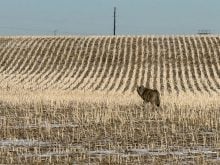When David Wenaus snapped a power line and ripped into a farmer’s field with his Cessna 188 last week , he became the 14th spray plane pilot since 1995 to be involved in a serious crash in Canada.
Wenaus survived his accident near Osage, Sask., but will be hospitalized for some time, said a family friend. The Fillmore, Sask., pilot’s accident came just days after another near Eslin, Sask., fostering public opinions that such accidents are more common than statistics show, say industry representatives. The pilot at Eslin walked away from his burning plane.
Read Also

Agritechnica Day 2: The future of tractor power, building quicker crop apps and large farms and tech
Agritechnica Day 2: The future of tractor power, building quicker crop apps with Syngenta and large farms and tech
“All of the flying takes place in five months or less and most of that in two or three,” said Jill Lane, of the Canadian Aerial Applicators Association in Edmonton. “The media are always quick to pick up on the news and so it appears accidents happen more often than they do.”
Government officials agree with Lane.
“Any time an airplane crashes, it gets a lot of media attention … considering the number of hours that are flown, aerial applicators have an excellent record,” said Ken Graham, with Transport Canada’s commercial aviation department.
Wenaus, like the pilot at Eslin, fell prey to the power line, a factor in field accidents but “not nearly as common a cause of crashes as one might think,” said Vic Gerden, regional manager of the Transport Safety Board of Canada.
“Half of all the serious accidents take place during takeoff … when the planes are loaded and being pushed to their limits. It is the time when things can go wrong. Pilots make reconnaissance flights to check for power lines and other hazards. They don’t crash while spraying too often,” said Gerden.
Plane design has improved in recent years and more often, job-specific planes are replacing modified light aircraft as agricultural spray planes. The specialized planes have roll cages that act as a protective capsule for pilots, keeping the flyer’s compartment together. Five-point harnesses hold them inside.
“They are designed like race cars. A lot of pilots wear fireproof suits, helmets and respirators. The pilot can usually walk away from a crash,” said Lane.
Another cause of accidents, said Gerden, is pilot fatigue: “All people are not the same and pilots that are following the regulations for duty days may still become fatigued.
“The creation of professional associations has also improved safety for applicators. The associations have their own insurance programs that require pilots to attend safety training seminars annually,” he said.
Transport Canada’s regulations require that pilots spend no more than 14 hours out of any 24 hours flying and that nine of the remaining hours be available for sleep and that a minimum of five hours be spent sleeping.
As well, at least five 24-hour periods must be spent not working out of each 30-day period.
Even in the busy periods pilots often get time to rest because of weather delays. During the afternoon, wind often interrupts work and pilots can have a nap, said Lane.
Time is the limited resource that pilots and farmers share, said Graham.
“A single weekend can sometimes spell disaster to farmers and most of the pilots we come into contact with are fully aware of the pressure farmers are under and do their best to get the work done on time and get it done as safely as possible,” he said.














